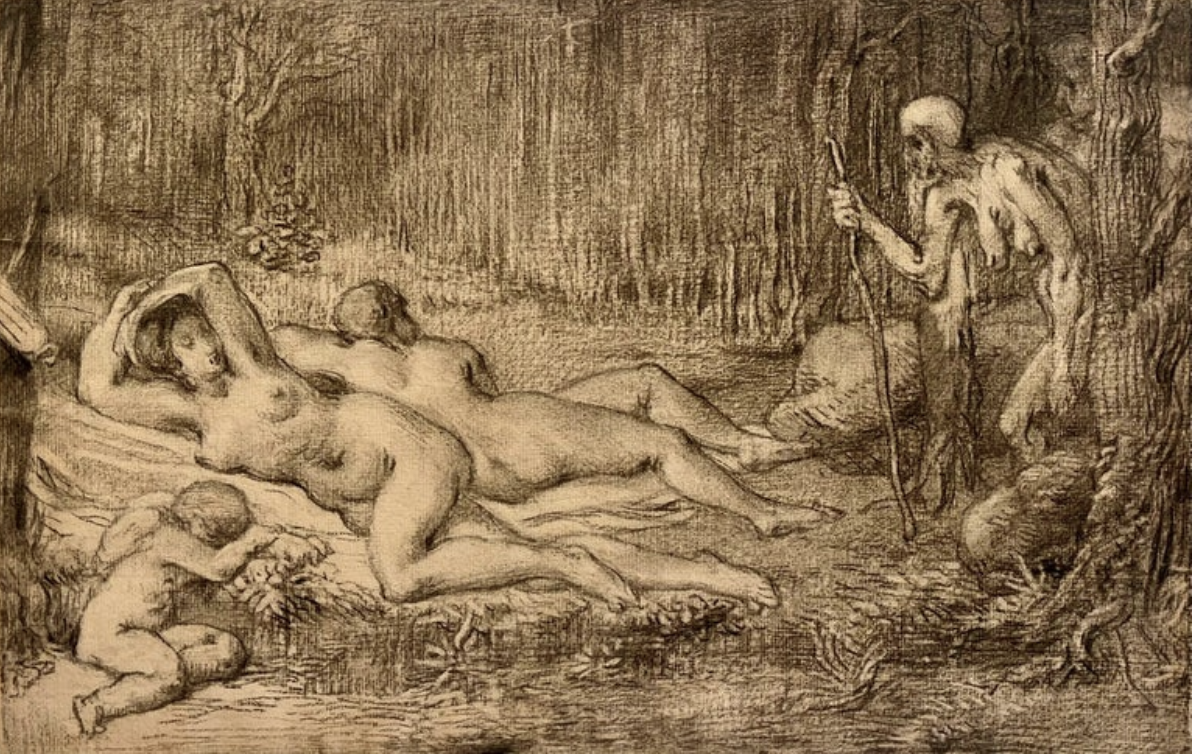 Image 1 of 5
Image 1 of 5

 Image 2 of 5
Image 2 of 5

 Image 3 of 5
Image 3 of 5

 Image 4 of 5
Image 4 of 5

 Image 5 of 5
Image 5 of 5






Waiting for Death
Artist: William P Babcock
Medium: Graphite on Paper
Creation Year: c. 1850s
Dimensions: 9.63 x 15.25 inches
Period: Mid 19th Century
Condition: Excellent
Description: William Babcock, born in Boston, began studying painting in Paris with Thomas Couture in 1847. He was the first American artist to establish a friendship with Jean François Millet, a key figure in the Barbizon school. The Barbizon school was part of a broader European movement towards greater naturalism in art, focusing on everyday subjects. Named after the village of Barbizon, located on the edge of the expansive Fontainebleau Forest near Paris, this school emphasized the beauty of ordinary scenes. Babcock played a pivotal role in introducing other American artists, including William Morris Hunt, George Inness, and Robert Loftin Newman, to Millet. At the time, Millet faced significant criticism from the French Academic art world. “Feeding the Rabbit” has a Venetian feel for form color and light which reflects his teacher, Thomas Contor, and the great Italian artist Tician, who he admired . This painting is signed lower right and comes with frame in perfect condition.
“Waiting for Death” is a haunting graphite drawing by American artist William Perkins Babcock, known for his symbolic and evocative works. In this powerful composition, Babcock explores themes of mortality and the inevitability of death. The drawing features two nude adult figures and a child, all lying down on the left side of the scene, their forms rendered with delicate shading that conveys vulnerability and resignation. On the right, a nude Grim Reaper-like creature looms, its skeletal form stark and ominous against the soft tones of the figures. The contrast between the living and the spectral presence of death creates a tension that is both unsettling and poignant. Babcock’s meticulous use of graphite captures the fragility of human life, while the arrangement of the figures suggests a narrative of acceptance and inevitability. “Waiting for Death” is a deeply introspective piece that invites viewers to reflect on the transient nature of existence.
Artist: William P Babcock
Medium: Graphite on Paper
Creation Year: c. 1850s
Dimensions: 9.63 x 15.25 inches
Period: Mid 19th Century
Condition: Excellent
Description: William Babcock, born in Boston, began studying painting in Paris with Thomas Couture in 1847. He was the first American artist to establish a friendship with Jean François Millet, a key figure in the Barbizon school. The Barbizon school was part of a broader European movement towards greater naturalism in art, focusing on everyday subjects. Named after the village of Barbizon, located on the edge of the expansive Fontainebleau Forest near Paris, this school emphasized the beauty of ordinary scenes. Babcock played a pivotal role in introducing other American artists, including William Morris Hunt, George Inness, and Robert Loftin Newman, to Millet. At the time, Millet faced significant criticism from the French Academic art world. “Feeding the Rabbit” has a Venetian feel for form color and light which reflects his teacher, Thomas Contor, and the great Italian artist Tician, who he admired . This painting is signed lower right and comes with frame in perfect condition.
“Waiting for Death” is a haunting graphite drawing by American artist William Perkins Babcock, known for his symbolic and evocative works. In this powerful composition, Babcock explores themes of mortality and the inevitability of death. The drawing features two nude adult figures and a child, all lying down on the left side of the scene, their forms rendered with delicate shading that conveys vulnerability and resignation. On the right, a nude Grim Reaper-like creature looms, its skeletal form stark and ominous against the soft tones of the figures. The contrast between the living and the spectral presence of death creates a tension that is both unsettling and poignant. Babcock’s meticulous use of graphite captures the fragility of human life, while the arrangement of the figures suggests a narrative of acceptance and inevitability. “Waiting for Death” is a deeply introspective piece that invites viewers to reflect on the transient nature of existence.
